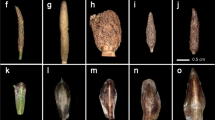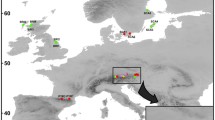Abstract.
From the predominantly aposporous Ranunculus cassubicus group, a subgroup of the R. auricomus complex, two species with both diploid and tetraploid cytodemes (R. cassubicifolius W. Koch and R. carpaticola Soó) were known. Nine population samples of both species have been analyzed for variation of ploidy levels and isozymes. DNA image analysis showed that three populations of R. cassubicifolius from Bavaria and Salzburg are diploid, two from Lower Austria tetraploid. In R. carpaticola, two populations from Central Slovakia and one from Romania are diploid, one from northern Slovakia is hexaploid. The polyploid populations had somewhat smaller C-values than expected from diploids. Ploidy levels are consistent within populations, contradicting previous hypotheses that cycles of diploid-tetra-ploid-dihaploid apomictic individuals occur in natural populations of goldilocks. Isozyme-allozyme analysis of nine polymorphic loci showed that individual variation and genetic measures of di-ploid and tetraploid populations are equivalent to those of sexual taxa. Multiple allelism and unbalanced gene dosages in tetraploid R. cassubicifolius give evidence for autopolyploidy that is most probably of multiple origin. The observed excess of homozygotes and the high diversity between populations in the diploid populations of R. cassubicifolius are most probably due to geographical isolation of population groups, that might have happened during the Würm glaciation and might have promoted the separation of autotetraploids in the easternmost part of the distribution range. Genetic distance values analyzed by UPGMA of all sexual populations separated the two taxa and the cytodemes within R. cassubicifolius. Multidimensional scaling of individuals (including the apomicts) based on a presence/absence matrix of alleles confirmed this differentiation with an overlapping zone between R. cassubicifolius and R. carpaticola. The hexaploid R. carpaticola population showed reduced genotypic diversity, an increased number of heterozygotes and fixed heterozygosity as typical for apomictic mode of reproduction. This population shared alleles of both species without any specific ones, multidimensional scaling placed genotypes among R. cassubicifolius. Thus, the hexa-ploid apomicts might have originated from hybrids of R. cassubicifolius and R. carpaticola. In general, evolution of agamic lineages in the R. cassubicus complex might have been facilitated by autopoly-ploids, because they can provide a bridge between the reproductive systems that are otherwise isolated by ploidy levels, and also a starting point for spontaneous origin of apomixis.
Similar content being viewed by others
Author information
Authors and Affiliations
Additional information
Received October 8, 2001; accepted May 10, 2002 Published online: November 7, 2002
Addresses of the authors: Elvia Hörandl (E-mail: elvira.hoerandl@univie.ac.at), Department of Systematics and Evolution of Higher Plants; Johann Greilhuber (E-mail: Johann.Greilhuber@univie. ac.at), Department of Systematic Karyology and Embryology of Plants; both: Institute of Botany, University of Vienna, Rennweg 14, A-1030 Vienna, Austria.
Rights and permissions
About this article
Cite this article
Hörandl, E., Greilhuber, J. Diploid and autotetraploid sexuals and their relationships to apomicts in the Ranunculus cassubicus group: insights from DNA content and isozyme variation. Plant Syst. Evol. 234, 85–100 (2002). https://doi.org/10.1007/s00606-002-0209-x
Issue Date:
DOI: https://doi.org/10.1007/s00606-002-0209-x




